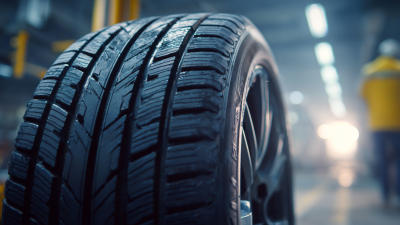Help is here
Exploring the Science Behind Tire Designs for Enhanced Vehicle Performance
In the realm of automotive engineering, the intricate design of tires plays a pivotal role in influencing vehicle performance, safety, and efficiency. As consumers become increasingly aware of how tire specifications can affect their driving experience, the need for accessible information has never been more pressing. This guide delves into the science behind tire designs, exploring essential factors such as tread patterns, rubber compounds, and structural integrity that contribute to enhanced vehicle performance. By leveraging resources available on a tire website, drivers can make informed choices that optimize their vehicles' handling, durability, and fuel efficiency.

Whether navigating urban landscapes or tackling rugged terrains, understanding the nuances of tire designs empowers consumers to select tires that align with their specific driving needs. Join us as we uncover the methodologies and innovations shaping the future of tire technology, ensuring that every journey is driven by performance-focused decisions.
The Role of Tire Composition in Grip and Durability: Insights from Recent Studies
The composition of tires plays a crucial role in determining their grip and durability, which are essential for optimizing vehicle performance. Recent studies indicate that advancements in tire materials, such as the introduction of high-performance synthetic rubbers and innovative compounds, significantly enhance traction. These materials improve the tire's ability to maintain contact with various road surfaces, leading to better handling and safety.
Moreover, the durability of tires is not solely reliant on their rubber composition; the integration of reinforcing materials, such as aramid and nylon, contributes to improved resistance against wear and tear. As the automotive industry shifts towards electric vehicles, understanding the specific demands placed on tires, such as weight distribution and heat dissipation, has become paramount. This development pushes manufacturers to innovate and develop tires that not only meet these challenges but also provide longer life spans and reduced rolling resistance, ultimately leading to enhanced vehicle efficiency.
Exploring Tire Composition's Impact on Grip and Durability
Impact of Tread Patterns on Vehicle Handling and Stability Performance Metrics
The interplay between tread patterns and vehicle handling is a critical aspect of automotive engineering that directly influences performance metrics. A report from the Tire Industry Association indicates that more than 30% of traction and handling capabilities in vehicles are attributable to the design of the tire tread. These patterns are not merely aesthetic; they are meticulously engineered to enhance grip on various surfaces under diverse conditions.
 For instance, longitudinal grooves in tread designs allow for efficient water evacuation, significantly reducing hydroplaning risk and improving stability during wet conditions. According to research published by the Society of Automotive Engineers (SAE), vehicles equipped with modern asymmetric tread patterns exhibit a 15% improvement in cornering stability compared to those with traditional symmetrical designs. This level of engineering ensures that drivers experience greater confidence and control, translating into improved performance metrics during both everyday driving and competitive racing scenarios.
For instance, longitudinal grooves in tread designs allow for efficient water evacuation, significantly reducing hydroplaning risk and improving stability during wet conditions. According to research published by the Society of Automotive Engineers (SAE), vehicles equipped with modern asymmetric tread patterns exhibit a 15% improvement in cornering stability compared to those with traditional symmetrical designs. This level of engineering ensures that drivers experience greater confidence and control, translating into improved performance metrics during both everyday driving and competitive racing scenarios.
Furthermore, the use of specialized sipes within tread designs can substantially enhance traction on icy and snowy surfaces, with some studies suggesting a performance increase of up to 20% in winter conditions. As drivers increasingly seek vehicles that can seamlessly transition between varying environmental challenges, the importance of optimizing tread patterns for enhanced vehicle handling and stability becomes ever more critical in the design and development of modern tires.
Hydraulic Effects: How Tire Inflation and Pressure Influence Efficiency and Safety
Tire inflation and pressure are critical factors influencing vehicle efficiency and safety, with a direct correlation to hydraulic effects on tire performance. According to the Tire Industry Association, the optimal tire pressure can enhance fuel efficiency by up to 3%, as properly inflated tires reduce rolling resistance.
 When tires are under-inflated, this resistance increases, leading to more energy consumption and higher fuel costs. For instance, data from the
National Highway Traffic Safety Administration reveals that under-inflated tires are responsible for approximately 600 fatalities and over 33,000 injuries annually due to compromised vehicle control.
When tires are under-inflated, this resistance increases, leading to more energy consumption and higher fuel costs. For instance, data from the
National Highway Traffic Safety Administration reveals that under-inflated tires are responsible for approximately 600 fatalities and over 33,000 injuries annually due to compromised vehicle control.
Moreover, the hydraulic aspects of tire design play a pivotal role in ensuring vehicle safety. A well-maintained tire at the correct pressure can adequately disperse water, minimizing hydroplaning risks in wet conditions. According to studies by the Rubber Manufacturers Association, tires inflated to their recommended pressure can provide up to 30% better grip on wet surfaces. This adherence to proper tire specifications not only enhances tire lifespan but also significantly lowers the likelihood of accidents caused by poor traction.
Therefore, regular monitoring of tire pressure and adherence to manufacturer recommendations is essential for any vehicle owner striving for optimal performance and safety.
Innovations in Tire Technology: Advancements in Materials and Design for Enhanced Performance
The world of tire design is undergoing a significant transformation, propelled by innovations in materials and engineering that aim to enhance vehicle performance. As manufacturers increasingly focus on developing advanced tire technologies, the integration of high-quality materials and cutting-edge designs becomes crucial. These advancements not only contribute to improved durability and safety but also enhance fuel efficiency, ultimately benefiting both consumers and the environment.
Recent projections indicate that the global commercial vehicle tire market is set to grow dramatically, from $20.71 billion in 2025 to $33.90 billion by 2032. This surge, characterized by a compound annual growth rate (CAGR) of 7.2%, reflects the growing demand for high-performance tires that can support rising vehicle production. As manufacturers invest in research and development, the future of the tire market appears promising, with innovations that are paving the way for tires that deliver superior grip, reduced rolling resistance, and greater overall performance, ensuring a more efficient driving experience.
Exploring the Science Behind Tire Designs for Enhanced Vehicle Performance
| Tire Feature | Material | Design Type | Performance Enhancement | Durability Rating (miles) |
|---|---|---|---|---|
| Tread Pattern | Silica-Based Compound | Symmetrical | Improved wet grip | 60,000 |
| Sidewall Strength | Aramid Fiber | Reinforced | Enhanced puncture resistance | 80,000 |
| Rolling Resistance | Eco-Friendly Rubber | Low Rolling Resistance | Fuel efficiency improvement | 50,000 |
| Noise Reduction | Noise-Absorbing Foam | Asymmetrical | Quieter ride | 70,000 |
| Heat Dissipation | Advanced Polymer Blend | Vented Design | Reduced heat build-up | 90,000 |
Environmental Considerations: Balancing Tire Development with Sustainability Goals in the Industry
The tire industry faces a significant challenge in balancing performance and sustainability. As vehicle performance becomes increasingly dependent on tire design, manufacturers are compelled to explore innovative materials and technologies that enhance driving characteristics without compromising environmental standards. This includes the development of eco-friendly materials, such as bio-based rubbers and recycled components, which reduce the carbon footprint associated with production processes.
Moreover, tire production involves extensive resource utilization, making it crucial for the industry to adopt practices that minimize waste and energy consumption. Sustainable tire development not only focuses on the manufacturing phase but also considers the lifecycle of tires, encouraging practices like recycling and repurposing worn-out tires. By integrating sustainability into tire design, manufacturers can create products that not only meet performance expectations but also contribute positively to environmental goals, aligning with the broader objectives of reducing greenhouse gas emissions and promoting circular economy principles within the automotive industry.
Related Posts
-

Unlocking the Secrets of Tire Fluid for Enhanced Vehicle Performance and Safety
-

Understanding the Importance of Tire Service in Reducing Road Accidents and Enhancing Vehicle Safety
-

Discover the Health Benefits of Dill Air for Enhanced Wellbeing
-

Ultimate Guide to Choosing the Right Tire for Your Vehicle on a Tire Website
-

Understanding the Importance of Tire Monitor Sensors for Safe Driving
-

Understanding the Impact of Tire Valve Sensors on Vehicle Safety and Fuel Efficiency
